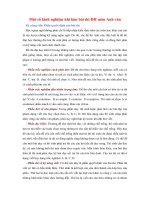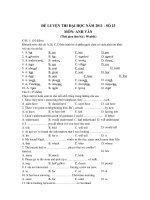Sổ tự học ANh VĂn 06-07
Bạn đang xem bản rút gọn của tài liệu. Xem và tải ngay bản đầy đủ của tài liệu tại đây (1.31 MB, 60 trang )
S
S
Y
Y
E
E
D
D
L
L
U
U
F
F
T
T
***
***
S
S
Teachers:
Teachers:
Ngô Minh Châu
Ngô Minh Châu
Phạm Lan Anh
Phạm Lan Anh
Student:
Student:
Trần Ngọc Phương Yến
Trần Ngọc Phương Yến
Class
Class
:
:
11C3
11C3
Content
PLANTS
PLANTS
Classification of all living things deriving their nourishment from
photosynthesis and lacking locomotive movement; the branch of
knowledge associated with them.
plant cell
Smallest living structure and the constituent
element of all vegetables; it varies in size
and shape depending on its function.
lichen
Vegetable formed from the symbiotic association of an alga and a fungus.
Structure of a lichen Examples of lichen
moss
Flowerless vegetable, usually small in size, that grows in large
tightly packed tufts to create a veritable soft carpet.
Structure of a moss Examples of a moss
alga
Flowerless vegetable that usually lives in aquatic environments; it
produces oxygen and is at the base of the food chain.
Structure of an alga Examples of an alga
mushroom
Organism that exists parasitically or symbiotically
with other living things or grows on dead organic matter.
Structure of a mushroom deadly poisonous mushroom poisonous mushroom
fern
Flowerless vegetable that grows mainly in the tropics;
it also grows in temperate climates in rich damp soil.
Structure of a fern examples of fern
plant
Vegetable rooted in the soil, the upper part of which
rows aboveground or in freshwater; it produces oxygen
and is at the bottom of the food chain.
Structure of a plant germination
Soil profile photosynthesis
Leaf
Usually thin and flat part of a vegetable that grows out of
the stem and is specially adapted to capturing light and
performing photosynthesis.
Structure of a leaf leaf margin
Simple leaves Compound leaves
flower
Often colorful and fragrant part of certain vegetables that
holds the reproductive organs; first it produces fruit,
then seeds.
Structure of a flower
Examples of flowers
types of inflorescences
fruits
Vegetable structures usually resulting from the development
of one or several floral ovaries that, once mature,
contain seeds; they are often edible.
Stone fleshy fruit pome fleshy fruit fleshy fruit: citrus fruit
fleshy fruit: berry fuit
plant cell
Smallest living structure and the constituent element of all vegetables; it varies in
size and shape depending on its function.
leucoplast
leucoplast
Small colorless structure that produces and stores starch, the vegetable’s food.
mitochondrion
mitochondrion
Ovoid organelle that produces the energy necessary for cell activity.
Golgi apparatus
Golgi apparatus
Organelle composed of a series of pockets that receive proteins produced by the
ribosomes and either transport them outside the cell or to other organelles.
vacuole
vacuole
Spherical cavity containing water, waste and various substances required by the cell.
cell membrane
cell membrane
Casing that covers the cell’s cytoplasm; it acts as a filter, controlling the passage of
certain substances in and out of the cell.
starch granule
starch granule
Concentric layers of starch produced by the cell and stored for food.
lipid droplet
lipid droplet
Small sac filled with essential fatty acids that are produced by the cell and stored for
food.
cytoplasm
cytoplasm
Clear gelatinous substance surrounding the various cellular structures.
nucleous
nucleous
Small spherical body located inside the nucleus, within which the ribosomes, or
protein-synthesizing structures, are produced.
nuclear envelope
nuclear envelope
A double-layered membrane enveloping the nucleus.
nucleus
nucleus
Organelle containing a cell’s genes and controlling its activities.
pore
pore
Perforations in the nuclear envelope allowing for exchanges between the cytoplasm and
the nucleus.
endoplasmic reticulum
endoplasmic reticulum
Interconnecting tubes allowing substances to be transported within the cell or between
the cell and its exterior environment.
plasmodesma
plasmodesma
Perforations in the membranes allowing two adjacent cells to exchange cytoplasm.
chloroplast
chloroplast
Small structure, containing a green pigment called chlorophyll, which absorbs solar
energy and uses it to produce glucose, the vegetable’s food.
ribosome
ribosome
Small structure, occasionally attached to the endoplasmic reticulum; it generates
proteins essential to the formation and functioning of living things.
cell wall
cell wall
Stiff exterior surface of the cytoplasmic membrane that gives the cell its shape.
Structure of a lichen
thallus
thallus
Lichen’s main structure formed by the imbrication of fungal filaments and alga cells.
apothecium
apothecium
Reproductive organ of the fungus that is a part of the lichen.
examples of lichens
There are more than 20,000 species of lichen, found growing out of the soil, on
tree trunks or on rocks; they grow in all climatic zones.
foliose lichen
foliose lichen
Lichen whose thallus resembles leaves or lobes that are loosely attached to their
substrate and can be easily removed.
crustose lichen
crustose lichen
Lichen whose thallus forms a crust that is firmly attached to its substrate.
fruticose lichen
fruticose lichen
Lichen whose thallus resembles a small tree; it is attached to its substrate at a single
point.
structure of a moss
structure of a moss
stalk
stalk
Long slender axis that supports the capsule, enabling it to absorb nutrients.
capsule
capsule
Hollow structure that manufactures spores, small seeds used in reproduction; it has a
cover that opens to release the mature spores.
rhizoid
rhizoid
Rootlike filament enabling the moss to anchor itself to its substrate and absorb water
and mineral salts.
stem
stem
Main part of the moss from which the leaves spiral outward; it can be upright or flat.
leaf
leaf
Part of the moss originating at the stem, especially adapted to capture light, perform
photosynthesis and absorb water.
examples of mosses
examples of mosses
There are more than 13,000 species of moss; they generally grow in damp soil, on
rocks or tree trunks and occasionally in fresh water.
prickly sphagnum
prickly sphagnum
Bog moss that has no rhizoid and rarely bears a capsule; it has a high water content and its
decomposition helps to form peat.
common hair cap moss
common hair cap moss
Ground moss with an erect stem and stiff leaves that grows in tufts, mostly in wooded
areas; the capsule emerges from the end of a very long stalk.
structure of an alga
structure of an alga
midrib
Projection running the length of the thallus or fronds of certain algae.
aerocyst
Small gas-filled bladder containing nitrogen and oxygen; it is located in the thallus of
some algae and provides buoyancy.
thallus
Alga’s main structure, with undifferentiated stem and leaves.
receptacle
Enlarged part, generally located at the tip of a frond, holding the alga’s reproductive
organs.
examples of algae
examples of algae
More than 25,000 species of algae live in aquatic environments or in some regions with
damp soil; they vary in size from microscopic to 60 ft in length.
brown alga
brown alga
Brown-pigmented alga that usually lives in the sea, often in cold water; there are
more than 1,500 species of brown algae.
green alga
green alga
Alga often found in freshwater, but also in seas and some nonaquatic environments;
there are 6,000 species of green algae.
red alga
red alga
Red-pigmented alga that generally lives in salt water and at greater depths than other
algae; there are 4,000 species of red algae.
hapteron
hapteron
Small, occasionally branched disk, located at the base of certain thalli, enabling their
attachment to a substrate.
lamina
lamina
Part of the thallus that is shaped like a blade; it is quite wide and looks like a leaf.
structure of a mushroom
structure of a mushroom
The mushroom is composed of an underground part (mycelium) and an
aboveground, often edible part that is also the reproductive organ.
spores
spores
Microscopic seeds acting as reproductive agents; they are usually released into the air
and fall on a substrate to produce a new mushroom.
stem
stem
Axis supporting the mushroom’s cap.
gill
gill
Fertile spore-producing part of the mushroom, located under the cap.
mycelium
mycelium
Tangle of hyphae created through spore germination, from which the aboveground part
of the mushroom develops.
hypha
hypha
Microscopic filament, often white, that draws water and the organic matter necessary
for mushroom development.
volva
volva
Remnant of a membrane that completely covered the immature mushroom and ruptured
as the stem grew.
ring
ring
Membrane located under the cap and circling the stem; remnant of a membrane that
covered the gills of the immature mushroom and ruptured as the cap grew.
cap
cap
Differently shaped and colored upper part of the mushroom that protects the gills; it
usually resembles a headdress, hence its name.
deadly poisonous mushroom
deadly poisonous mushroom
Mushroom containing a toxin that, following contact or ingestion, produces
serious effects on humans, generally resulting in death.
destroying angel
White ground mushroom with an unpleasant smell, growing in wooded areas; the effects of
its often-deadly toxin act in a delayed manner, mainly attacking the liver.
Poisonous mushroom
Poisonous mushroom
Mushroom containing a toxin that, following contact or ingestion, produces a
range of usually nonfatal effects on humans.
fly agaric
The cap of this woodland mushroom is covered with white warts; its toxin primarily
attacks the nervous system, causing hallucinations, among other symptoms.
Structure of a fern
sorus
Cluster of small spore-producing structures covering the underside of a pinna.
Structure of a fern
blade
blade
Main part of the frond, rich in chlorophyll.
adventitious roots
adventitious roots
Roots that grow out of the rhizome, enabling the fern to anchor itself to the soil and
absorb water and mineral salts from it.
rhizome
rhizome
Stem usually found underground that grows horizontally, occasionally vertically, out of
which adventitious fronds and roots grow.
fiddlehead
fiddlehead
Immature fern frond; its coiled tip is shaped like the head of a fiddle.
petiole
petiole
Slender part of the frond connecting the blade to the rhizome.
pinna
pinna
Segment of the frond’s blade, the underside of which bears sori.
frond
frond
Fern leaf, originating at the rhizome, that bears sori and is especially adapted to capture
light and perform photosynthesis.
sorus
sorus
Cluster of small spore-producing structures covering the underside of a pinna.
Examples of ferns
Examples of ferns
There are more than 10,000 species of fern, varying in height from a a fraction
of an inch to several feet.
tree fern
Large fern that resembles a tree and can reach heights of up to 65 ft; it grows mainly in
the tropics.
trunk
Main part of the fern, composed of a vertical rhizome covered with the stubs of old
fronds and, often, with aboveground adventitious roots.
bird’s nest fern
Fern that usually grows out of another plant without deriving nourishment from it; its
fronds grow in a rosette around a central rhizome, hence its name.
common polypody
Fern with fronds up to a foot long; it is usually found in damp overgrown soil, on rocks
or tree trunks.
Structure of a plant
Structure of a plant
flower bud
flower bud
Bud that opens and from which a flower grows.
radicle
radicle
Smallest offshoot of a plant’s root.
root system
root system
The aggregate of the roots that anchor a plant to the soil and enable it to absorb water
and mineral salts from it.
primary root
primary root
Underground extension of the stem resulting from growth of the radicle.
collar
collar
Point where root and stem meet.
leaf
leaf
Usually thin and flat part of a vegetable that grows out of the stem and is specially
adapted to capturing light and performing photosynthesis.
shoot
shoot
Seedling originating from a seed within the current year.
secondary root
secondary root
Offshoot growing out of the primary root.
stem
stem
Main part of the plant, extending from the soil to the terminal bud.
leaf node
leaf node
Point at which a leaf or twig attaches to the stem.
twig
twig
Offshoot growing out of the plant’s stem.
flower
flower
Often colorful and fragrant part of certain vegetables that holds the reproductive
organs; first it produces fruit, then seeds.
axillary bud
axillary bud
Bud that appears where an older leaf attaches to the stem; a twig will grow out of it.
terminal bud
terminal bud
Bud that grows at the end of the stem, enabling it to grow longer.
internode
internode
Part of the stem located between two nodes.
root hairs
root hairs
Root cell extensions that ensure the provision of water and mineral salts; they increase
the surface area available for absorbing nutrients.
root cap
root cap
Casing that covers the root tip and protects the root from abrasion as it grows
downward into the soil.
Germination
Germination
Phenomenon by which, given favorable conditions, a seed will develop and
grow into a plant.









